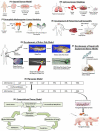Cancer models in preclinical research: A chronicle review of advancement in effective cancer research
- PMID: 34179717
- PMCID: PMC8212826
- DOI: 10.1002/ame2.12165
Cancer models in preclinical research: A chronicle review of advancement in effective cancer research
Abstract
Cancer is a major stress for public well-being and is the most dreadful disease. The models used in the discovery of cancer treatment are continuously changing and extending toward advanced preclinical studies. Cancer models are either naturally existing or artificially prepared experimental systems that show similar features with human tumors though the heterogeneous nature of the tumor is very familiar. The choice of the most fitting model to best reflect the given tumor system is one of the real difficulties for cancer examination. Therefore, vast studies have been conducted on the cancer models for developing a better understanding of cancer invasion, progression, and early detection. These models give an insight into cancer etiology, molecular basis, host tumor interaction, the role of microenvironment, and tumor heterogeneity in tumor metastasis. These models are also used to predict novel cancer markers, targeted therapies, and are extremely helpful in drug development. In this review, the potential of cancer models to be used as a platform for drug screening and therapeutic discoveries are highlighted. Although none of the cancer models is regarded as ideal because each is associated with essential caveats that restraint its application yet by bridging the gap between preliminary cancer research and translational medicine. However, they promise a brighter future for cancer treatment.
Keywords: cancer cell lines; computational cancer models; genetically engineered mouse models; organoids; patient‐derived xenografts; personalized medicine.
© 2021 The Authors. Animal Models and Experimental Medicine published by John Wiley & Sons Australia, Ltd on behalf of The Chinese Association for Laboratory Animal Sciences.
Figures



References
-
- Wang C, Tang Z, Zhao Y, Yao R, Li L, Sun W. Three‐dimensional in vitro cancer models: a short review. Biofabrication. 2014;6(2):022001. - PubMed
-
- Vargo‐Gogola T, Rosen JM. Modelling breast cancer: one size does not fit all. Nat Rev Cancer. 2007;7(9):659‐672. - PubMed
-
- Voskoglou‐Nomikos T, Pater JL, Seymour L. Clinical predictive value of the in vitro cell line, human xenograft, and mouse allograft preclinical cancer models. Clin Cancer Res. 2003;9(11):4227‐4239. - PubMed
Publication types
MeSH terms
LinkOut - more resources
Full Text Sources
Medical
Miscellaneous

